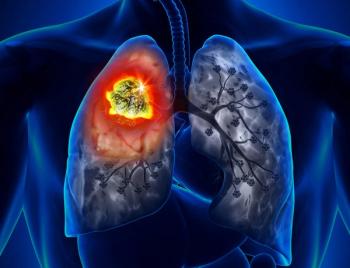
Oncology NEWS International
- Oncology NEWS International Vol 9 No 8
- Volume 9
- Issue 8
Biologic Markers Predict Recurrence Risk in NSCLC
NEW ORLEANS-A study of biologic markers in non-small-cell lung cancer (NSCLC) has identified several that appear to predict disease recurrence. They also offer some insight into the mechanisms by which NSCLC tumors spread.
NEW ORLEANSA study of biologic markers in non-small-cell lung cancer (NSCLC) has identified several that appear to predict disease recurrence. They also offer some insight into the mechanisms by which NSCLC tumors spread.
The study, from Leicester Royal Infirmary, Leicester, UK, aimed to identify predictive markers, to construct a molecular staging model, and to suggest novel therapeutic targets through better understanding of the molecular biology of the tumors. Currently, the best prognostic index for operable NSCLC remains the TNM staging system.
Lead investigator Giles Cox, MD, reported the results at the 36th Annual Meeting of the American Society of Clinical Oncology (ASCO).
Dr. Cox and his colleagues studied surgically removed tumors from 168 patients with stage I to IIIa NSCLC. Paraffin-embedded tissue from these patients tumors was stained for substances that have been implicated in the pathogenesis of NSCLC:
Matrix metalloproteinases (MMP) 2 and 9, which are endopeptidases capable of digesting the extracellular matrix and allowing migration of tumor and endothelial cells.
The levels of two epidermal growth factors (EGFR and HER2/neu, also known as c-erB-2) on the tumor surface, which may be involved in the upreg-ulation of MMP-9.
The microvessel marker CD34, to evaluate for angiogenesis.
The DAKO HercepTest evaluated for HER2/neu overexpression. All immunohistochemical evaluations were conducted by two independent observers blinded to outcomes. Clinical characteristics such as disease stage, nodal status, and tumor grade were also considered in the evaluation.
The analysis showed that the presence of MMP-9 in tumor cells predicted a poor outcome, but the prognosis was even worse when both EGFR and MMP-9 were found in the same tumor. If all three markers were presentEGFR, MMP-9, and angiogenesis5-year cancer-related mortality was as high as 84%, Dr. Cox reported.
On multivariate analysis, the following factors were independent predictors of poor prognosis: high microvessel counts (P = .002), tumor cell MMP-9 (P = .009), nodal status (P = .01), and tumor grade (P = .05).
EGFR expression itself was not associated with outcome, but was inversely correlated with angiogenesis (P = .04) and positively correlated with tumor cell MMP-9 expression (P < .001). Patients with microvessel counts over the median number and expressing both EGFR and MMP-9 had a particularly poor outcome (P < .0001), he said.
Membranous HER2 expression was positive in only 3 of 168 cases. MMP-2 was not associated with outcome.
In the subgroup of 25 patients who expressed EGFR, MMP-9, and high microvessel count, 21 patients have died from a recurrence of cancer, giving a cancer-specific mortality of 84% in this group, Dr. Cox said. There was one long-term survivor in this group, but he has just been admitted to the hospital for a mediastinal recurrence.
He concluded that angiogenesis and tumor cell MMP-9 both confer poor prognosis in NSCLC, and EGFR is associated with MMP-9 in vivo. We can induce MMP-9 mRNA by stimulating epidermal growth factor in vitro. This suggests there is a signaling pathway between EGFR and MMP-9 upregulation.
The investigators developed a staging model using the three major immunohistochemical markers, with which to predict patients at high risk for recurrence after surgery. These high-risk patients would be potential targets for adjuvant treatment, at this time with conventional chemotherapy but, in the future, using therapy targeting the pathway that is activated in the particular tumor. Such therapy might include tyrosine kinase inhibitors, MMP inhibitors, or antiangiogenesis agents, which have fewer side effects than conventional agents, he said.
Articles in this issue
over 25 years ago
Scientists Identify Gene Mutations in Multiple Myelomaover 25 years ago
Single-Agent Herceptin Active in Metastatic Breast Cancerover 25 years ago
Brain Metastases Respond to Paclitaxel, Carboplatin, and Brain RTNewsletter
Stay up to date on recent advances in the multidisciplinary approach to cancer.


















































































